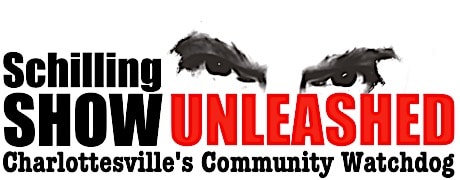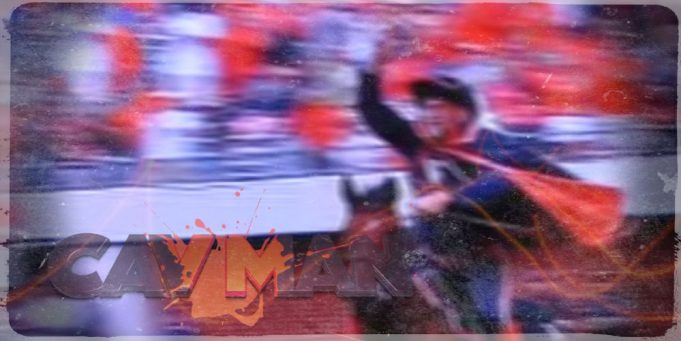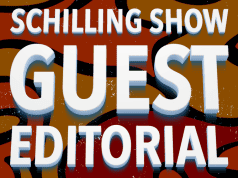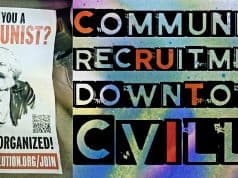by: James C. Wilson, Jr.
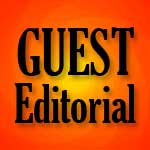 Given all that we are currently witnessing in regards to the eradication of history and the destruction and removal of long standing statues and memorials—in the name of the much touted notion of “White Supremacy”— the application of what is passing for logic these days, has offered up many targets, with most certainly, more to follow. If I let go of a hammer on a cliff side, the laws of gravity assure me that I need not see it fall to know that it has in fact fallen. Since man’s fall and ejection from the Garden, one thing is certain. Human beings have characteristics just as inanimate objects do. The characteristic of the depravity of the human mind and the chaos it is capable of rarely ceases on its own. Like the many wildfires of California, which consume all fuel till there is no more, this Cancel Culture movement will not cease until it eradicates everything in its path, for cessation is not its nature. Therefore I submit that which will undoubtedly become a target before all of this foolishness is finished.
Given all that we are currently witnessing in regards to the eradication of history and the destruction and removal of long standing statues and memorials—in the name of the much touted notion of “White Supremacy”— the application of what is passing for logic these days, has offered up many targets, with most certainly, more to follow. If I let go of a hammer on a cliff side, the laws of gravity assure me that I need not see it fall to know that it has in fact fallen. Since man’s fall and ejection from the Garden, one thing is certain. Human beings have characteristics just as inanimate objects do. The characteristic of the depravity of the human mind and the chaos it is capable of rarely ceases on its own. Like the many wildfires of California, which consume all fuel till there is no more, this Cancel Culture movement will not cease until it eradicates everything in its path, for cessation is not its nature. Therefore I submit that which will undoubtedly become a target before all of this foolishness is finished.CAVALIER, noun
- A horseman, especially an armed horseman; a knight.
- A sprightly, military man.
- The appellation of the party of King Charles I.
- In fortification, an elevation of earth, situated ordinarily in the gorge of a bastion, bordered with a parapet, with embrasures.
- In the manege, one who understands horsemanship; one skilled in the art of riding.
CAVALIER, adjective
- sprightly; warlike; brave; generous.
- Haughty; disdainful.
A recent announcement by the Thomas Jefferson Health District, informed the public of its decision to rename itself The Blue Ridge Health District—as Thomas Jefferson was a slave holder, and his name may prevent patients from seeking treatment there because of it. Although no statistical abstracts exist to support this point, a new name thus it shall be. Even though it was slave holder Thomas Jefferson, who coined the phrase The Blue Ridge Mountains, but that is self-evidently beside the point. If we continue to apply the current logic further, then the University of Virginia must select a different mascot, as the Washington Redskins were forced to do. Indeed, U. Va has already capitulated to a degree, when it redesigned its V-sabre logo and the Cavalier Shield, removing the curved sabre grips because the serpentine wall it was referencing, was built by slaves. Let’s not concern ourselves with all of the other structures constructed on the grounds in the same manner. However, if 150 year old statues of men on horseback allegedly instills terror into individuals, what then must be the traumatic effect of a real live man galloping up and down the field on a real live horse, waving a real sabre induce? What exactly are “Cav Mans” origins, and can they be connected to slavery and white supremacy?
In its early English usages, the word “cavalier” is used to designate a chivalrous fellow or a gracious martial man. During the English Civil Wars, it was an accusation used to pronounce Royalists who sustained King Charles I and hailed war in his name; it also came to mean irresponsible or offhand. Royalists misappropriated the term, employing it instead to suggest bravery, chivalry, and loyalty. This positive connotation of the word is the one that took hold in Virginia culture in the seventeenth century, thus creating “The Cavalier myth” which commonly submits that after the king was vanquished, Royalists assembled into a compassionate Virginia, helping to create and solidify a unique philosophy grounded in gentility and an unwavering social order. This ignores the fact that many of the English people who immigrated in Virginia during this period, were not truly from so-called Cavalier families, rather, they were indentured servants. Additionally, comparatively hardly any of the Virginia influential, were the king’s followers, even in England.
Faith also was a component in Virginia’s conversion into a perceived Royalist bastion. Most Virginia planters belonged to the Church of England and look upon Puritans, who held the same religious dogmas as many Parliamentarians, including Oliver Cromwell, as answerable for the war that endangered their king and destabilized their safety. In 1642 the General Assembly passed legal code requiring all ministers in Virginia to obey the Church of England and granted the right to exorcize any nonconformists. The legislation stiffened the coalition with the Royalist, anti-Puritan cause and contributed to the characterization of the Virginia Cavalier as one who displayed fealty to the Crown and observed the doctrine of the Church of England.
Though Virginians were not occupied in the military features of the conflicts in England, they opposed its new Commonwealth government in 1649, proclaiming Charles II after receiving news that Parliament had tried and executed Charles I. It reacted by ordering a blockade of the colony. Virginia’s demonstration of loyalty to the monarchy helped reinforce its Royalist identity, in so doing Virginians attached the military attributes of Charles’s army to themselves. These features were strengthened in the eighteenth century and tell the interpretation of Virginia history beyond the revolutionary period.
Another characteristic of existence in colonial Virginia that animated the Cavalier myth was the military muster. A ritual of gathering the area’s able-bodied men for military assessment and drill. This custom empowered an honored grouping of individuals based on social order, establishing a microcosm of male-dominated Anglo-Virginian society in which the right to assemble tenants, freeholders, and gentry lay with those attached to Virginia’s prominent families. The relationship between the top ranks and the rest of the assembled men was dependent on a legally installed system of dignity, honor, and obligation. All characteristics that had been established to represent the positive characteristics associated with the Royalists a century earlier. The Virginia militia statute required stringent adherence to military rank during drilling exercises; as a reward, the county-lieutenant would often give the men plentiful quantities of alcohol, provoking some contemporary observers to disparage the muster as an undisciplined excuse to get drunk. Despite that the militia provided an important means of formalizing authority in society and assemblies at which the male fraternity of warriors might get drunk together. So I suppose we can also attribute the other title/mascot of the University of Virginia, “The Wahoo” to the celebration of the Cavalier as well. This amalgamation of military tradition and socialized alcoholism merged typical Cavalier attributes such as horsemanship, militarism, rank, honor, and obligation with the model’s less alluring qualities: negligence, flippancy, conceit, and depravity.
Virginia allied breeding and gentility with its masculine governance well into the early nineteenth century, despite the American Revolution with its emphasis on Democratic Republic. This mindset served to eventually remove the Royalist connection to the term “cavalier,” though the elite authority in Virginia continued to be typified by men of wealth, plantation owners and the like, who successfully governed their landholdings while also engaging in military, sporting, and leisure activities. As Virginia embraced its regionalism under increasing outside criticism of slavery and the plantation system, historians and novelists attempted to galvanize the symbol of the male patron-protector, projecting an image of a hero whose mission was to uphold the traditions of the Old Dominion in the face of encroaching outside influence. Over time, the image was transformed. Becoming more an embodiment of certain ideals of character and conduct than an objective historical representation of an actual class of men. Like so many tales and legends, although its origin is historical, Virginia during the seventeenth and eighteenth centuries historically record a class of wealthy planters who delivered the broad framework for the Cavalier myth. Many of these planters were in fact gentlemen of distinction, and they aspired to follow a distinctive code of conduct, romanticizing the Cavalier figure in history. The literary works of Scottish historical novelist Walter Scott on mid-nineteenth-century southern writings initiated a renewed relevance in medieval mythology, prompting the use of the term “chivalry” to stand for Southern ideals. Ultimately, the term Cavalier presented idealized depictions of real-life revolutionaries, such as Patrick Henry with the citizenry encouraged to visualize them as ambassadors of the ancient world and the contemporary—the past and future.
The American Civil War reinforced the Cavalier exemplar, with the clash granting a renewal of factual and sentimentalized heroism of Virginia’s men. The Army of Northern Virginia, the most effective Confederate army of the war, fortified important victories in the eastern portion of the South, and its generals, including Robert E. Lee and J. E. B. Stuart, became synonymous with the Cavalier archetype. Statues commemorating these Confederate leaders present in many Virginian towns and cities, currently being removed are a touchstone signifying a modern connection to the leadership of Virginia’s fighting men.
Which brings us now into the present. Without a doubt, the iconic image of the Cavalier is arguably the single most recognizable image of Anglo-Virginian identity. As such and as also the official mascot of the University of Virginia, the Cavalier, symbolized by an orange and blue rider wearing a plumed hat, prompts students and alumni to cheer their team. We easily can observe the word “Cavalier”, as it appears in the names of businesses across Virginia. Historical societies have erected numerous monuments to men whose attributes embodied the Cavalier ideal. While this is simply a figure, an image, a symbol of a historically established institution by the author of the Declaration of Independence, I fear that to many, the image of the Cavalier will come under the same feckless scrutiny as so many other long held traditions, symbols and ideology, and simply be stated to represent the dominance of the ruling class. A narrative that shall become as perverted and twisted as everything else of historical or artistic value has become here in The Cradle of the Republic. Most certainly, after the cancel culture intelligentsia are finished their rewriting of American history, no doubt the history of Virginia will be portrayed as one predicated upon the ruling class privileged, a certain segment of the population, tyrannizing several other equally important groups. A narrative heretofore negligent of the English created and Northern supported institution of slavery under an ethos supposedly meant to uphold standards of honor and benevolence. It could also be argued that this same historicism also appears to discount or marginalize the hundreds of thousands of people who immigrated to Virginia throughout the colonial period and worked as indentured servants or tradesmen. A trend that survived in varying degrees until the middle of the twentieth century.
So as we endeavor to reestablish our cultural and societal equilibrium, and reacquire some sense of the normalcy enjoyed prior to March, and with the importance economically that Mr. Jefferson’s University holds for so many local businesses and government tax coffers, let us hope that “Cav Man” does not fall into the vortex that has thus far pulled down statuary from our local courthouse and all across the Commonwealth, and whose destructive results have already rolled across the lawn as a juggernaut, leaving nothing but sewage upon its door posts. We can only hope that if such objections are fomented, that Jim Ryan and the Board of Visitors will not succumb to this as they have with everything else thus far.
I am not holding my breath.


